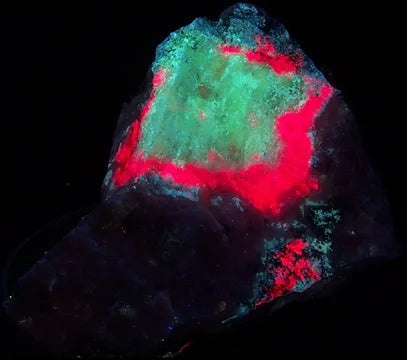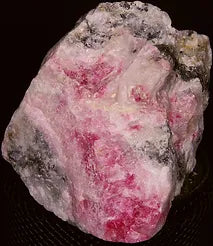Tugtupite was discovered in 1957 close to the town of Narsaq and to-date has only been found in two other areas - Mt. St. Hilaire (Canada) and the Kola Peninsula (Russia). Tugtupite at Kvanefjeld is scattered in irregular hydrothermal veins up to 50cm wide. Only tugtupite from Greenland is deeply colored and valued as a gemstone.

Chemical formula: Na4AlBeSi4O12Cl. Hardness = 6.5, Density = 2.35 Tugtupite varies in color from white, pink, to red and crimson. Some blue/white specimens have been recorded. The fluorescence is a brilliant red under short-wave ultraviolet light, and a salmon-red under longwave UV. After exposure to UV (or exposure to sunlight) the red coloration is enhanced (tenebrescense). Tugtupite occurs as irregular forms in whitish albite veins with grey-green lujavrite rock. It can be found throughout the Ilimaussaq Complex, but the specimens from Kvanefjeld are the most sought after - as both jewelry rough and mineral specimens. It is most often found associated with chkalovite, albite, analcime, beryllite, aegirine, neptunite, and pyrochlore. Tugtupite forms as a replacement of chkalovite. Most often it is massive, very few well developed crystals have been found.


Tugtupite from the Kvanefjeld area is the most widely known fluorescent mineral from Ilimaussaq. It is typically a bright gemmy red and is the source for the gem material used in making beautiful tugtupite cabochons. A typical piece of gem tugtupite will be found in an analcime and lujavrite matrix, often along with aegirine crystals. The natural color ranges from a light pink to a deep cherry red. Under shortwave the red glow is unmistakable. Commonly associated (fluorescent) minerals include chkalovite, beryllite, and sorensenite.

Taseq Tugtupite – Found in veins towards the top of the slopes, this variety of tugtupite is quite different from that found on Kvanefjeld. It consists of a coarse grained pink veining in massive crystals of analcime. Often pieces are associated with aegirine (non FL) and what appears to be a spotty green fluorescent analcime (or remnants of chkalovite). Many pieces have vugs where micro crystals of tugtupite can be found. Daylight color ranges from a light pink to deep pink, This material is also usually quite phosphorescent. It also usually shows a significant color change under midwave UV light.

Tugtupite Crystals – One of our tour members in 2002 found a boulder of tugtupite on the eastern slopes. When he cracked it open he found a cavity of wonderfully formed tugtupite crystals! Since then, many pieces have been found with micro crystals but this piece was truly remarkable in size. Although not a gemmy red, the tugtupite deepened in color to an intense pink.
A coating of what appears to be a uranyl activated green FL covered many areas on the specimens, along with a yellowish glow – perhaps from another associated (unknown) mineral.
Kangerluarsuk Tugtupite - A gem variety of tugtupite found in the Kangerluarsuk Fjord area. Usually associated with polylithionite, chkalovite, and sodalite. Responses vary widely under different wavelengths and is very bright material










